Laure Prouvost
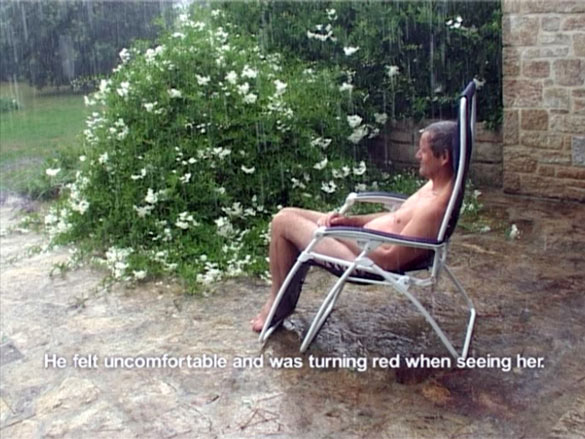
THIS PAGE TASTE OF SWEET RASPBERRY IN YOUR MOUTH…
THIS TEXT SLAPS YOU IN THE FACE TO KEEP YOU ALERT…
Chez Laure Prouvost, le texte, les images, les sons, les objets veulent toujours être « plus ». Rien n’est normal, rien n’est seulement ce qu’il est sensé être. Tout est en cours de transformation, de traduction, en train de se perdre, d’être raconté et ressenti. Ce rapport particulier aux choses, elle l’évoque comme étant l’une des raisons qui l’ont poussée vers l’art. Une difficulté initiale avec les mots et, surtout, l’envie de les utiliser de façon imaginative, à travers un langage artistique qui permet de voir et d’imaginer ce que l’on ne voit pas. Ces phrases, tantôt agressives, drôles, douces, et tantôt « goût framboise », reviennent de façon récurrente dans ses films et dans ses installations. Dans le cadre de Frieze Projects en 2011 à Londres, elle dispose des pancartes à travers toute la foire. Des lettres majuscules blanches se détachent sur un fond noir qui survient comme une trappe s’ouvrant au visiteur et dans laquelle la normalité glisse et s’enfuit, laissant place à l’imagination. Au détour d’un couloir, on pouvait lire : IDEALLY THIS SIGN WOULD PROVOKE THUNDERSTORM AND LIGHTNING AS YOU READ, ou encore IT’S ALL HAPPENING BEHIND THIS WALL. Pendant un instant, on oublie que l’on est en train de lire pour s’abandonner à une vision, personnelle à chacun. Laure Prouvost joue avec l’autorité. Elle aime dire qu’elle ne montre rien, que c’est à nous de tout imaginer et cite volontiers Marcel Broodthaers : « Je ne crois pas au cinéma, pas plus qu’à un autre art. Je ne crois pas non plus en l’artiste unique ou en l’œuvre unique. Je crois à des phénomènes et à des hommes qui réunissent des idées » [1].
Le langage de Laure Prouvost est intraduisible, car ce sont précisément les malentendus ou les moments où la langue fourche qui l’intéressent. Française expatriée à Londres depuis quatorze ans, elle a vu le potentiel de ses erreurs de traduction et des moments de confusion. Dès 2007, avec la vidéo Owt réalisée avant son entrée au Goldsmiths College [2], elle utilise les sous-titres et sa propre voix de façon à souligner des glissements de sens : c’est le langage des commentateurs de l’art et du cinéma que Laure Prouvost désarticule avec humour. La vidéo s’ouvre avec un violent bruit de verre brisé puis sur le texte : « Full concentration is now requested. Questions will be asked at the end ». Le curateur Michael Connor apparaît à l’écran et parle de théorie du cinéma et de films d’artistes, citant notamment Walter Benjamin. Dès le début, les sous-titres perdent le fil du contenu, ne gardant avec lui qu’une connexion rythmique et phonétique. « Art is also a set of social relationship » devient « And in his farm he also sale related sheep ». La narration se perd dans un univers absurde et saccadé avec vaches, chèvres, mécano buvant du whisky, le tout comme souvent, dans un anglais approximatif. Comme dans beaucoup de ses films, Laure Prouvost utilise l’effet intime de sa voix et s’adresse au spectateur doucement, comme à demi éveillée : « what’s going on ? ». Que se passe-t-il ? Elle s’assure que nous sommes conscients de notre statut de spectateur et de l’espace qui nous entoure. La narration est entrecoupée d’un flux d’images banales — une limace, un supermarché — et par des écrans colorés, des bruits, un coup de téléphone.
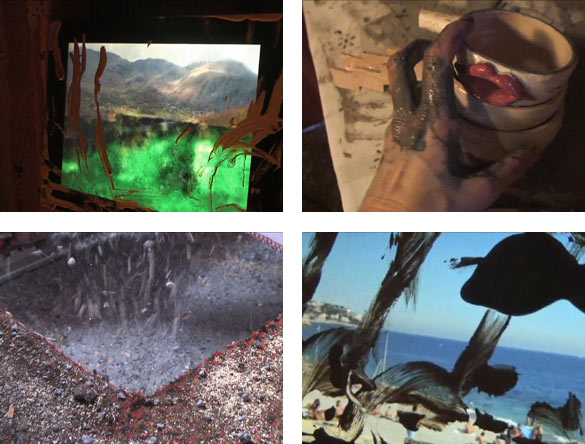
Laure Prouvost. Wantee, 2013. Vidéo still / Still from video installation. Courtesy Laure Prouvost ; MOT International
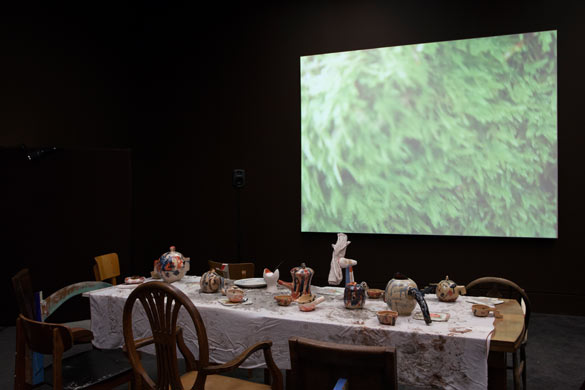
Laure Prouvost. Vue de l’installation / Installation view of Wantee in Schwitters in Britian, 2013. Tate Britain, Londres. Courtesy Laure Prouvost ; MOT International.
Laure Prouvost se présente souvent comme le témoin et le narrateur d’une banalité et d’un quotidien qui vacillent vers la fiction et le surréel par petits moments, le temps d’une respiration ou d’un battement de cœur. Elle filme au quotidien, de façon spontanée, créant une banque d’images réutilisables dans la plupart de ses projets. Depuis des années, elle réalise aussi ce qu’elle appelle des hand videos et qui fonctionnent comme un carnet de notes ou un journal. Elle y utilise le potentiel narratif des objets qui l’entourent et en modifie la signification, comme dans une nouvelle de Gogol ou à la manière d’un enfant qui découvre son environnement, l’explique, s’arrête de façon obsessive et émerveillée sur des détails qui deviennent de plus en plus étranges. Ces vidéos, très courtes, souvent hilarantes et qui ne montrent généralement que les mains de l’artiste gesticulant, nourrissent son travail de part et d’autre. Ces histoires, personnages, objets, reviennent dans la plupart de ses travaux. On y rencontre par exemple son « grand-père fictionnel », un artiste conceptuel porté disparu lors de la réalisation de sa dernière grande œuvre visant à creuser un tunnel pour rejoindre l’Afrique depuis le milieu de son salon. Il y a aussi le chat, la grand-mère, des légumes qui tombent du ciel. La figure de ce grand-père apparaît pour la première fois avec I Need to Take Care of My Conceptual Grand Dad (2010), l’une des cinq vidéos réalisées pour une exposition à Flat Time House, la maison et l’atelier de John Latham (1921-2006) dont elle fut l’assistante. Cependant, le personnage prend toute son envergure dans The Artist (2010). Laure Prouvost — ou son personnage — se trouve dans l’atelier de ce grand père disparu, filmée de façon chaotique et très rapprochée dans un entrelacement fantastique et émotionnel d’anecdotes proches du trouble de l’attention et de la perte totale de contrôle. Sa façon de filmer est à la fois claustrophobique, désorientée et surchargée de matières et d’informations… Le grand-père et les objets agissent comme le moteur de la narration. Présentée à Frieze Frame en 2010 dans un environnement répliquant l’atelier et ses objets devenus reliques, The Artist invitait le public à exister physiquement dans la narration et vice versa. Souvent chez Laure Prouvost, l’art est sujet à malentendus : « Regarde derrière » incite-t-elle… L’arrière des toiles de marché aux puces collectionnées par le grand-père révèle littéralement la passion de l’artiste conceptuel pour les peintures de derrières. L’incompréhension que génère le travail artistique du vieil homme est l’un des sujets de l’installation vidéo Wantee (2013) produite récemment par la Tate Britain et qui vaut à l’artiste une nomination au prestigieux Turner Prize en octobre prochain. Encore une fois, le film y devient un espace, traduit en installation. On se trouve dans le salon du grand-père, lieu couvert de terre et abandonné depuis sa disparition dans le fameux tunnel. Faute d’intérêt récent des grands musées pour ses œuvres, sa grand-mère les avait réintroduites dans leur environnement domestique. Rien n’est évident : des sculptures sont devenues porte-manteau, repose-coude, égouttoir à vaisselle… La grand-mère désespérée, ses rêves et sa chambre à coucher, feront l’objet d’un nouveau projet qui viendra sans doute se greffer à la présentation de Wantee pour le Turner Prize. Le grand-père, quant à lui, reste perdu et incompris, état qu’il partage avec bien d’autres personnages.
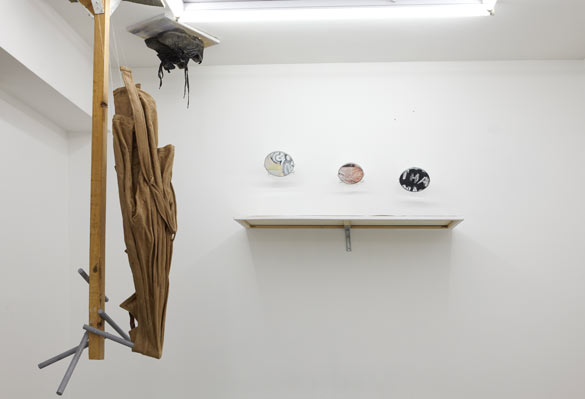
Laure Prouvost. Vue de l’installation / Installation view of Why does Gregor never rings? Shut your lips, somewhere under that bridge lies the hole truth… (The Wanderer sequence 5), 2012 chez / at MOT International, Londres. Courtesy Laure Prouvost; MOT International.
De 2011 à 2012, Laure Prouvost a réalisé un long métrage intitulé The Wanderer d’après la traduction de La Métamorphose de Kafka produite par l’artiste Rory MacBeth sans connaissance de l’allemand, ni dictionnaire. Cette première traduction subit la seconde interprétation de Laure Prouvost, en scénario et puis en film. Au cours de six séquences indépendantes, pour la plupart montrées également sous forme d’installations, Laure Prouvost introduit Gregor perdu entre passé et présent, se cachant dans des garde-meubles, téléphonant avec des combinés non branchés et cherchant son amour, Betty, qui se perd dans une ivresse que l’on pourrait également attribuer à la caméra. La langue, l’image, le montage, tout accompagne cette plongée drolatique dans l’absurdité de la conscience des personnages et leurs ressentis.
Si le travail de Laure Prouvost a souvent été commenté dans un héritage structuraliste, ses œuvres ne s’y limitent pas et incorporent un vocabulaire complexe lié à la sculpture, à la performance, au collage et à la poésie. Elles ne se réduisent pas non plus à des univers anxieux. Chacune des œuvres évoquées contient un débordement de matières, de couleurs, de sons et de sensations, comme en témoigne son dernier projet, Farfromwords (2013), présenté à la Whitechapel de Londres au printemps : les images, chez Laure Prouvost, veulent être plus qu’elles ne sont. Elles peuvent être plaisir, désir et respiration. Il s’agit de l’empathie qu’elles peuvent générer, d’émotions liées à des sensations et que le langage ne traduit pas, comme la sensation de marcher dans une flaque d’eau et de « sentir le soleil sur son visage ».
- ↑ Entretien avec Marcel Broodthaers, Trépied, n°2, février 1968, Bruxelles.
Note pour le traducteur : version anglaise, même source : “I don’t believe in film, nor do I believe in any other art. I don’t believe in the unique artist or the unique work of art. I believe in phenomena, and in men who put ideas together.” - ↑ Elle a d’abord étudiée à Central Saint Martins de 1999 à 2002.
Biennale de Lyon, 12.09.13 _5.01.2014, commissariat /curated by: Gunnar B. Kvaran.
« No Fear, No Shame, No Confusion », Liz Magor, Jean-Marie Appriou, Andrea Büttner, Laure Prouvost, Triangle France, Friche Belle de Mai, Marseille, 11.10.2013_2.02.2014, commissariat /curated by: Céline Kopp.
Exposition des quatre artistes nommés au Turner Prize, Derry-Londonderry, Irlande du Nord, du 23.10. 2013_5.01.2014. Le nom du lauréat sera annoncé le 2 décembre 2013.
- Biennale de Lyon, 12.09.13 _5.01.2014, commissariat / curated by: Gunnar B. Kvaran.
- « No Fear, No Shame, No Confusion », Liz Magor, Jean-Marie Appriou, Andrea Büttner, Laure Prouvost, Triangle France, Friche Belle de Mai, Marseille, 11.10.2013_2.02.2014, commissariat / curated by: Céline Kopp.
- Exposition des quatre artistes nommés au Turner Prize, Derry-Londonderry, Irlande du Nord, du 23.10. 2013_5.01.2014. Le nom du lauréat sera annoncé le 2 décembre 2013 / Exhibition of the four artists nominated for the Turner Prize, Derry-Londonderry, Northern Ireland, from 23 October 2013 to 5 January 2014. The winner’s name will be announced on 2 December 2013.
Laure Prouvost
THIS PAGE TASTE OF SWEET RASPBERRY IN YOUR MOUTH…
THIS TEXT SLAPS YOU IN THE FACE TO KEEP YOU ALERT…
In Laure Prouvost’s work, text, imagery, sounds and objects always want to be “more”. Nothing is normal, nothing is just what it is meant to be. Everything is in the process of transformation, translation, being lost, being recounted, and felt. She refers to this particular relation to things as being one of the reasons that pushed her towards art. An initial difficulty with words and, above all, a desire to use them in an imaginative way, through an artistic language that makes it possible to see and imagine what you do not see. These sentences, at times aggressive, funny and gentle, at others “with a raspberry flavour”, are recurrent in her films and in her installations. As part of Frieze Projects in 2011 in London, she put signs all over the fair. White capital letters stood out against a black ground that loomed up like a hatch opening up to visitors, into which normality slid and stole away, giving way to imagination. In a corridor, you could read: IDEALLY THIS SIGN WOULD PROVOKE THUNDERSTORM AND LIGHTNING AS YOU READ, and IT’S ALL HAPPENING BEHIND THIS WALL. For a split second, you forgot that you were reading and you abandoned yourself to a vision, personal for each visitor. Laure Prouvost plays with authority. She is fond of saying that she does not show anything, that it is up to us to imagine everything, and she readily quotes Marcel Broodthaers: “I don’t believe in film, nor do I believe in any other art. I don’t believe in the unique artist or the unique work of art. I believe in phenomena, and in men who put ideas together.” [1]
Laure Prouvost’s language cannot be translated, because it is precisely the misunderstandings and the moments when language forks that interest her. This French expatriate woman who has lived in London for fourteen years has seen the potential of her errors in translation and moments of confusion. In 2007, with the video Owl made before she enrolled at Goldsmith’s College [2], she used subtitles and her own voice in such a way as to underline shifts of meaning: it is the language of commentators on art and film that Laure Prouvost wittily takes apart. The video opens with a violent noise of broken glass, then with the words: “Full concentration is now requested. Questions will be asked at the end”. The curator Michael Connor appears on the screen and talks about film theory and artists’ films, mentioning in particular Walter Benjamin. From the outset, the subtitles lose track of the content, keeping just a rhythmic and phonetic connection with it. “Art is also a set of social relationships” becomes “And in his farm he also sells related sheep”. The narrative goes astray in an absurd, jolting world with cows, goats, and a mechanic drinking whisky, everything, as is often the case, in an approximate English. As in many of her films, Laure Prouvost uses the intimate effect of her voice and addresses the viewer softly, as if half-awake: “What’s going on?” She makes sure that we are aware of our viewer status, and of the space around us. The narrative is interspersed with a flow of commonplace images—a slug, a supermarket – and by coloured screens, noises, a phone call.

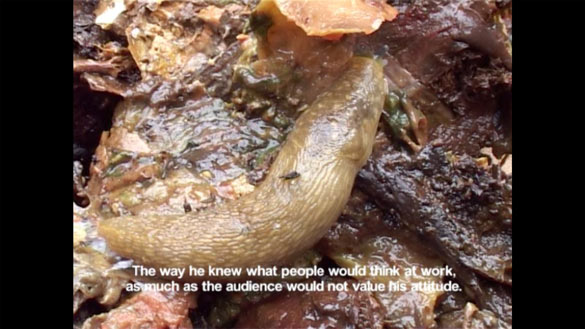
Laure Prouvost Owt, 2007. Vidéo HD / HD video, 3’20. Courtesy Laure Prouvost ; MOT International.
Laure Prouvost often comes across like the witness and narrator of something banal and day-to-day, wavering towards fiction and the surreal in brief moments, for the duration of a breath or a heartbeat. She films the daily round, in an off-the-cuff way, creating a bank of images that can be re-used in most of her projects. For years she has also been producing what she calls “hand videos”, which work like a notebook or diary. In them she uses the narrative potential of the objects surrounding her, and alters their meaning, like in a Gogol short story, or like a child discovering its surroundings; she explains things, dwells in an obsessive and amazed way on details which become ever stranger. These very short and often hilarious videos, which usually show just the artist’s gesticulating hands, inform her work in every sense. These stories, characters and objects recur in most of her works. In them, for example, we meet her “fictional grandfather”, a conceptual artist who was reported missing during the production of his last great work, aimed at digging a tunnel to reach Africa from the middle of his living room. There is also the cat, the grandmother, and vegetables falling from the sky. The figure of this grandfather appears for the first time with I Need to Take Care of my Conceptual Grand Dad (2010), one of the five videos made for a show at Flat Time House, the house and studio of John Latham (1921-2006), whose assistant she was. But the character assumes his full stature in The Artist (2010). Laure Prouvost — or her character — finds herself in the studio of this deceased grandfather, filmed in a chaotic, very close-up way in a fantastic and emotional intertwining of similar anecdotes to do with attention disorder and total loss of control. Her way of filming is at once claustrophobic, disoriented and overloaded with matter and information… The grandfather and the objects act as the driving force behind the narrative. Screened at Frieze Frame in 2010, in an environment that was a replica of her studio and her objects that had become relics, The Artist invited the audience to physically exist within the narrative, and vice versa. Often with Laure Prouvost, art is subject to misunderstandings: “Look behind ”, she urges… The backs of flea-market canvases collected by the grandfather literally reveal the conceptual artist’s keen interest in paintings of backsides. The lack of understanding created by the old man’s artistic work is one of the subjects of the video installation Wantee (2013), recently produced for Tate Britain, which earned the artist a nomination for the prestigious Turner Prize last October. Once again, the film here becomes a space, translated into an installation. We are in the grandfather’s living room, a place covered with earth and abandoned since his death in the famous tunnel. For lack of recent interest from major museums in his works, her grandmother put them back in their domestic surroundings. Nothing is obvious: sculptures have become coat stands, elbow rests, draining boards… The desperate grandmother, her dreams and her bedroom will be the object of a new project which will probably be attached to the presentation of Wantee for the Turner Prize, the grandfather, for his part, remains lost and misunderstood, a state he shares with plenty of other characters.
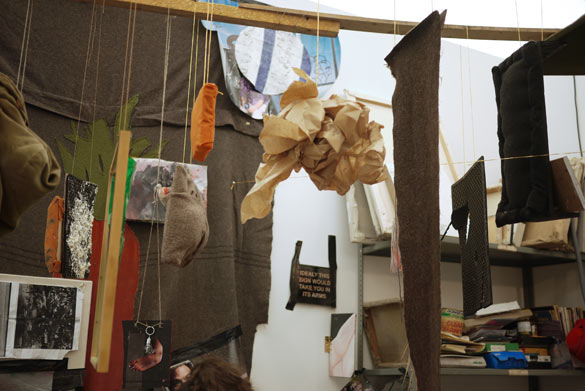
Laure Prouvost. The Artist, 2010. Installation vidéo / Video installation. Courtesy Laure Prouvost ; MOT International.
Between 2011 and 2012, Laure Prouvost made a feature film called The Wanderer, based on Kafka’s The Metamorphosis, as translated by the artist Rory MacBeth, with no knowledge of German, and no dictionary. This first translation underwent Laure Prouvost’s second interpretation, as a screenplay and then as a film. For six independent sequences, most of them also shown in the form of installations, Laure Prouvost introduces Gregor lost somewhere between past and present, hiding in wardrobes, telephoning with telephones that are not hooked up and looking for his love, Betty, lost in a drunkenness that might also be attributed to the camera. Language, imagery and editing all accompany this funny plunge into the absurdity of the consciousness of the characters and what they feel. If Laure Prouvost’s work has often been commented upon in a structuralist heritage, her works are not limited to this, and incorporate a complex vocabulary associated with sculpture, performance, collage and poetry. Nor are they reduced to anxious worlds. Each one of the works mentioned contains an overspill of matter, colour, sound and sensation, as illustrated by her latest project, Farfromwords (2013), shown at the Whitechapel Gallery in London in the spring: images, with Laure Prouvost, want to be more than they are. They may be pleasure, desire and breathing. It is a question of the empathy they can give rise to, of emotions linked to sensations, which language does not translate, like the sensation of walking in a puddle of water and “feeling the sun on your face”.
articles liés
Iván Argote
par Patrice Joly
Laurent Proux
par Guillaume Lasserre
Diego Bianchi
par Vanessa Morisset

